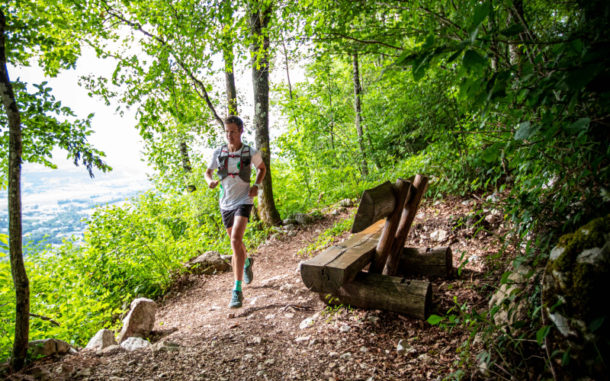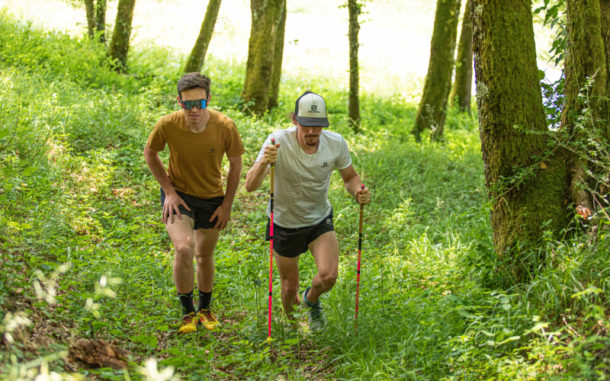
Uphill sections in trail running present a prime opportunity to gain time, or at least, minimize loss! Mastering these uphill segments is crucial in trail running to achieve your objectives, be it in terms of time, placement, or simply progressing in the sport. Here are some tips to enhance your uphill performance, especially useful if you’re gearing up for a trail race or find these segments challenging.
Contents
Running or Walking Uphill?
There’s no definitive answer. Similar to nutrition in trail running, it’s highly personal. Some runners walk and move as swiftly as others who run. Walking often becomes more effective when the slope reaches a certain steepness. Particularly, when the incline is extremely steep (15-20% and above), walking becomes nearly unavoidable.
Why walk? For efficiency! On one hand, walking will lower your heart rate. On the other hand, you will save muscular energy, allowing you to last longer. Walking is not a sign of weakness but rather a sign of intelligence compared to others who run on steep slopes.
Remember, even the world’s top trail runners walk! Walking is a crucial strategy in trail running, helping conserve energy for longer durations. For effective uphill walking, you can place your hands on your thighs, focus on shorter, more frequent steps, and if using poles, stand upright to facilitate easier breathing and more effective pole use.
Using Poles

The use of poles is another debated topic, with no universal right answer but rather best practices.
For shorter distances (from 20 to 50 km), poles are not mandatory. It all depends on the type of terrain (how much elevation change there is) and on your level and familiarity. For distances over 50 km, mid-pack runners often use poles.
What are the advantages of using poles? They help save leg muscle strength and allow you to endure longer distances. Poles also help maintain a more upright posture, thus facilitating breathing. What are the disadvantages? They add extra weight to carry, and there’s the hassle of folding, unfolding, and storing them. Sometimes, with poles, there’s a tendency to start walking sooner than necessary, even though one could still be running.
If you use poles in a race, don’t forget to test them during your long training runs. Running with poles is a skill that can be learned!
Specific Training for Running Uphill Performance
To improve uphill, you must train on hills, undoubtedly. There are different types of hill sessions you can do to improve. The easiest is the hike-and-run outing: these are fundamental endurance outings in the mountains. You work at low intensity, so you can run downhill and on flat surfaces, and walk uphill.
Short Hills
To improve your power and explosiveness, you can work with short hills on short effort durations. For this type of effort, you can train on an asphalt hill because you’ll be running quite fast. You’ll be more focused on your stride and positioning on this less technical terrain. An example of a typical session: 12x30sec with recovery jog downhill or 8×1′ with recovery jog downhill. This effort corresponds to what is called MAP (zone 5).
Long Hills or Threshold Training
In races, you’ll often find climbs ranging from 400m to 1000m of elevation gain and more. It’s important to work on long efforts uphill. Unlike short hills, these sessions are done at threshold pace, the pace you’ll have in a race (zone 3 to zone 4). In terms of duration, repetitions can be between 6 minutes to 30 minutes depending on the distances you are preparing for. The goal is to do several climbs at race pace with active recovery jogging downhill. Here is an example of a session: 3x10min or 4x8min.
Steep Hill Training
Finally, to be thorough, you can train on very steep slopes by walking to get used to the transition between running and walking. You can also do sessions with varied slopes: start on more rolling terrain and finish on very steep sections.
Specific Strength Training for Trail Running
To be strong uphill and make progress, you can include specific strength training for trail running. In the RunMotion Coach training plans, we offer specific strength exercises for trail running (in Premium mode).
Why strengthen? To be more powerful uphill and therefore go faster. Your muscles undergo a heavy load during a trail run; they need to be able to withstand it, so it’s important to strengthen them.
Now you’re ready to improve your uphill performance! You can prepare for your next trails with RunMotion Coach training plans. These are personalized and adaptive programs that will lead you to success.